RETRACTED: Mechanical, Durability, and Microstructural Evaluation of Coal Ash Incorporated Recycled Aggregate Concrete: An Application of Waste Effluents for Sustainable Construction
Abstract
1. Introduction
2. Experimental Program
2.1. Materials and Properties
2.2. Testing Methodology
3. Discussion of Results
3.1. Mechanical Performance
3.1.1. Compressive Strength
3.1.2. Split Tensile Strength
3.2. Durability Performance
3.2.1. Water Absorption
3.2.2. Chloride Ion Migration
3.2.3. Resistance against H2SO4 Attack
3.3. Statistical Analysis
3.4. Scanning Electron Microscopic Analysis
4. Conclusions
- 1.
- The CS of the FRAC blend fabricated using textile factory effluent at ninety days was maximum at a value of 30.5 MPa, which was 19% more improved than the CS of concrete manufactured with potable water. The inclusion of coal ash resulted in a pozzolanic interaction between CH and coal ash particles, which led to a surge in the CS of FRAC. Furthermore, the inclusion of coal ash into concrete surges the density of the matrix. A strong bond developed between cement and sand particles due to CSH gel.
- 2.
- At ninety days, the STS of concrete made with textile industry effluent was approximately 115 percent more improved than the STS of concrete made with potable water. When equated with concrete produced using potable water, the FRAC compositions made with fertilizer factory effluent had a maximum STS of 97 percent, the mix made with leather factory effluent had a maximum STS of 92 percent, the service station effluent FRAC mix had a maximum STS of 99 percent, and the sugar factory effluent FRAC mix had a maximum STS of 95 percent.
- 3.
- The test results revealed that, among all the different FRAC compositions, concrete made with leather factory effluent had the highest WA, i.e., 113 percent and 121 percent at twenty-eight and ninety days, separately. This depicts that concrete made using leather factory effluent has a lot of pores and less density, being less durable. The coal ash inclusion reduced the WA of FRAC compositions.
- 4.
- The maximum level of chloride ion migration showed by concrete manufactured utilizing fertilizer factory effluent, i.e., 16 mm at twenty-eight days and 10.8 mm at ninety days as compared to the control mix.
- 5.
- The results of tests in which FRAC compositions were exposed to a 4 percent solution of revealed that the FRAC mix made with fertilizer factory effluent lost mass due to acid attack, i.e., 19 percent after 120 days. This could be explained by the fact that the pH value of fertilizer factory effluent was the lowest (2.5), which enhanced the mass loss. Adding coal ash to FRAC compositions proved to be helpful for the development of the durability behavior of the concrete.
- 6.
- The ANOVA analysis revealed major variations between the CS and chloride ion migration results of different FRAC blends. On the other hand, FRAC mixtures exhibited no significant changes in STS, WA, or acid attack. Therefore, the investigated types of effluent can be utilized to make efficient concrete, which leads to waste material availability and long-term environmental impact.
- 7.
- The SEM results depicted that the mix TEX presented the most densified microstructure with the formation of CSH gels and ettringite needles, having an improved ITZ compared with the other types of effluent, thus leading to the enhanced mechanical and durability performance of the FRAC mix.
Author Contributions
Funding
Data Availability Statement
Acknowledgments
Conflicts of Interest
References
- McGinnis, M.J.; Davis, M.; De La Rosa, A.; Weldon, B.D.; Kurama, Y.C. Quantified sustainability of recycled concrete aggregates. Mag. Concr. Res. 2017, 69, 1203–1211. [Google Scholar] [CrossRef]
- Coelho, A.; de Brito, J. Influence of construction and demolition waste management on the environmental impact of buildings. Waste Manag. 2012, 32, 532–541. [Google Scholar] [CrossRef]
- Azúa, G.; González, M.; Arroyo, P.; Kurama, Y. Recycled coarse aggregates from precast plant and building demolitions: Environmental and economic modeling through stochastic simulations. J. Clean. Prod. 2018, 210, 1425–1434. [Google Scholar] [CrossRef]
- Xiao, J.Z.; Wang, C.; Ding, T.; Akbarnezhad, A. A recycled aggregate concrete high-rise building: Structural performance and embodied carbon footprint. J. Clean. Prod. 2018, 199, 868–881. [Google Scholar] [CrossRef]
- Silva, R.V.; Brito, J.D.; Dhir, R.K. Fresh-state performance of recycled aggregate con-crete: A review. Constr. Build. Mater. 2018, 178, 19–31. [Google Scholar] [CrossRef]
- Ozbakkaloglu, T.; Gholampour, A. Time-dependent and long-term mechanical properties of concretesincorporating different grades of coarse recycled concrete aggregates. Eng. Struct. 2018, 157, 224–234. [Google Scholar]
- Oh, D.-Y.; Noguchi, T.R.; Kitagaki, W.; Park, J. CO2 emission reduction by reuse of building material waste in the Japanese cement industry. Renew. Sustain. Energy Rev. 2014, 38, 796–810. [Google Scholar] [CrossRef]
- Kurad, R.; Silvestre, J.D.; de Brito, J.; Ahmed, H. Effect of incorporation of high volume of recycled concrete aggregates and fly ash on the strength and global warming potential of concrete. J. Clean. Prod. 2017, 166, 485–502. [Google Scholar] [CrossRef]
- Tariq, H.; Siddique, R.M.A.; Shah, S.A.R.; Azab, M.; Rehman, A.U.; Qadeer, R.; Ullah, M.K.; Iqbal, F. Mechanical Performance of Polymeric ARGF-Based Fly Ash-Concrete Composites: A Study for Eco-Friendly Circular Economy Application. Polymers 2022, 14, 1774. [Google Scholar] [CrossRef]
- Raza, A.; Shah, S.A.R.; Kazmi, S.N.H.; Ali, R.Q.; Akhtar, H.; Fakhar, S.; Khan, F.N.; Mahmood, A. Performance evaluation of concrete developed using various types of wastewater: A step towards sustainability. Constr. Build. Mater. 2020, 262, 120608. [Google Scholar] [CrossRef]
- Raza, A.; Rafique, U. Efficiency of GFRP bars and hoops in recycled aggregate concrete columns: Experimental and numerical study. Compos. Struct. 2020, 255, 112986. [Google Scholar] [CrossRef]
- More, A.B.; Ghodake, R.B.; Nimbalkar, H.N.; Chandake, P.P.; Maniyar, S.P.; Narute, Y.D. Reuse of treated domestic wastewater in concrete—A sustainable approach. Indian J. Appl. Res. 2014, 4, 182–184. [Google Scholar] [CrossRef]
- Al-Jabri, K.; Al-Saidy, A.; Taha, R.; Al-Kemyani, A. Effect of using Wastewater on the Properties of High Strength Concrete. Procedia Eng. 2011, 14, 370–376. [Google Scholar] [CrossRef]
- Ghafoor, S.; Hameed, A.; Shah, S.A.R.; Azab, M.; Faheem, H.; Nawaz, M.F.; Iqbal, F. Development of Construction Material Using Wastewater: An Application of Circular Economy for Mass Production of Bricks. Materials 2022, 15, 2256. [Google Scholar] [CrossRef]
- Hassani, M.S.; Asadollahfardi, G.; Saghravani, S.F.; Jafari, S.; Peighambarzadeh, F.S. The difference in chloride ion diffusion coefficient of concrete made with drinking water and wastewater. Constr. Build. Mater. 2019, 231, 117182. [Google Scholar] [CrossRef]
- Verian, K.P.; Ashraf, W.; Cao, Y. Properties of recycled concrete aggregate and their influence in new concrete production. Resour. Conserv. Recycl. 2018, 133, 30–49. [Google Scholar] [CrossRef]
- Kisku, N.; Joshi, H.; Ansari, M.; Panda, S.; Nayak, S.; Dutta, S.C. A critical review and assessment for usage of recycled aggregate as sustainable construction material. Constr. Build. Mater. 2017, 131, 721–740. [Google Scholar] [CrossRef]
- Xiao, J.; Li, W.; Fan, Y.; Huang, X. An overview of study on recycled aggregate concrete in China (1996–2011). Constr. Build. Mater. 2012, 31, 364–383. [Google Scholar] [CrossRef]
- Contreras Llanes, M.; Romero Pérez, M.; Gázquez González, M.J.; Bolívar Raya, J.P. Construction and demolition waste as recycled aggregate for environmentally friendly concrete paving. Environ. Sci. Pollut. Res. 2021, 29, 1–15. [Google Scholar]
- Kaplan, G.; Gulcan, A.; Cagdas, B.; Bayraktar, O.Y. The impact of recycled coarse aggregates obtained from waste concretes on lightweight pervious concrete properties. Environ. Sci. Pollut. Res. 2021, 28, 17369–17394. [Google Scholar] [CrossRef]
- Ali, B.; Fahad, M.; Mohammed, A.S.; Ahmed, H.; Elhag, A.B.; Azab, M. Improving the performance of recycled aggregate concrete using nylon waste fibers. Case Stud. Constr. Mater. 2022, 17, e01468. [Google Scholar] [CrossRef]
- Ali, B.; Qureshi, L.A.; Shah, S.H.A.; Rehman, S.U.; Hussain, I.; Iqbal, M. A step towards durable, ductile and sustainable concrete: Simultaneous incorporation of recycled aggregates, glass fiber and fly ash. Constr. Build. Mater. 2020, 251, 118980. [Google Scholar] [CrossRef]
- Sivamani, J.; Renganathan, N.T. Effect of fine recycled aggregate on the strength and durability properties of concrete modified through two-stage mixing approach. Environ. Sci. Pollut. Res. 2021, 1–14. [Google Scholar] [CrossRef] [PubMed]
- Yang, F.; Yao, Y.; Wang, X.; Wei, J.; Feng, Z. Preparation of recycled and multi-recycled coarse aggregates concrete with the vibration mixing process. Buildings 2022, 12, 1369. [Google Scholar] [CrossRef]
- McNeil, K.; Kang, T.H.-K. Recycled concrete aggregates: A review. Int. J. Concr. Struct. Mater. 2013, 7, 61–69. [Google Scholar] [CrossRef]
- Rahal, K. Mechanical properties of concrete with recycled coarse aggregate. Build. Environ. 2007, 42, 407–415. [Google Scholar] [CrossRef]
- Dabhade, A.; Choudhari, S.; Gajbhiye, A. Performance evaluation of recycled aggregate used in concrete. Int. J. Eng. Res. Appl. 2012, 2, 1387–1391. [Google Scholar]
- López-Uceda, A.; Galvín, A.P.; Barbudo, A.; Ayuso, J. Long-term leaching and mechanical behaviour at recycled aggregate with different gypsum contents. Environ. Sci. Pollut. Res. 2019, 26, 35565–35573. [Google Scholar] [CrossRef]
- Etxeberria, M.; Vázquez, E.; Mari, A.; Barra, M. Influence of amount of recycled coarse aggregates and production process on properties of recycled aggregate concrete. Cem. Concr. Res. 2007, 37, 735–742. [Google Scholar] [CrossRef]
- Mukharjee, B.B.; Barai, S.V. Influence of Nano-Silica on the properties of recycled aggregate concrete. Constr. Build. Mater. 2014, 55, 29–37. [Google Scholar] [CrossRef]
- Li, W.; Xiao, J.; Sun, Z.; Kawashima, S.; Shah, S.P. Interfacial transition zones in recycled aggregate concrete with different mixing approaches. Constr. Build. Mater. 2012, 35, 1045–1055. [Google Scholar] [CrossRef]
- Huda, S.B.; Shahria Alam, M. Mechanical and freeze-thaw durability properties of recycled aggregate concrete made with Recycled coarse aggregate. J. Mater. Civ. Eng. 2015, 27, 04015003. [Google Scholar] [CrossRef]
- Duan, Z.; Poon, C.S. Properties of recycled aggregate concrete made with recycled aggregates with different amounts of old adhered mortars. Mater. Des. 2014, 58, 19–29. [Google Scholar] [CrossRef]
- Wang, X.; Yan, Y.; Tong, X.; Gong, Y. Investigation of mineral admixtures on mechanical properties of alkali-activated recycled concrete Powders Cement. Buildings 2022, 12, 1234. [Google Scholar] [CrossRef]
- Bílek, V. Development of alkali-activated concrete containing recycled wash water. In Proceedings of the 2nd Int. Conf. Sustain. Constr. Mater. Technologies, Ancona, Italy, 28 June 2010; pp. 309–318. [Google Scholar]
- Cebeci, O.Z.; Saatci, A.M. Domestic sewage as mixing water in concrete. ACI Mater. Jour. 1989, 86, 503–506. [Google Scholar]
- Sandrolini, W.; Franzoni, E. Waste wash water recycling in ready mixed concrete plants. Cem. Concr. Res. 2001, 31, 485–489. [Google Scholar] [CrossRef]
- Lee, O.S.S.; Salim, M.R.; Ismail, M.R.; Ali, M.I. Reusing treated effluent in concrete technology. Jour. Tech. 2001, 34, 1–10. [Google Scholar]
- Ghusain, A.I.; Terro, M.J. Use of treated wastewater for concrete mixing in Kuwait. Kuw. Jour. Sci. Eng. 2003, 30, 213–228. [Google Scholar]
- Shekarchi, M.; Yazdian, M.; Mehrdadi, N. Use of biologically treated domestic wastewater in concrete. Kuw. Jour. Sci. Eng. 2009, 39, 97–111. [Google Scholar]
- Asadollahfardi, G.; Asadi, M.; Jafari, H.; Moradi, A.; Asadollahfardi, R. Experimental and statistical studies of using wash water from ready-mix concrete trucks and a batching plant in the production of fresh concrete. Constr. Build. Mater. 2015, 98, 305–314. [Google Scholar] [CrossRef]
- Yao, X.; Xu, Z.; Guan, J.; Liu, L.; Shangguan, L.; Xi, J. Influence of wastewater content on mechanical properties, microstructure, and durability of concrete. Buildings 2022, 12, 1343. [Google Scholar] [CrossRef]
- Asadollahfardi, G.; Tahmasabi, G.; Nabi, S.M.; Pouresfandyani, H.; Hossieni, S.A.A. Effects of using concrete wash water on a few characteristics of new concrete. Environ. Eng. Manag. J. 2017, 16, 1569–1575. [Google Scholar] [CrossRef]
- Wasserman, B. Wash Water in the Mix: Effects on the Compressive Strength of Concrete. Int. J. Constr. Educ. Res. 2012, 8, 301–316. [Google Scholar] [CrossRef]
- Saxena, S.; Tembhurkar, A.R. Developing biotechnological technique for reuse of wastewater and steel slag in bio-concrete. J. Clean. Prod. 2019, 229, 193–202. [Google Scholar] [CrossRef]
- Bahraman, M.; Asadollahfardi, G.; Salehi, A.M.; Yahyaei, B. Feasibility study of using wash water from ready mixed concrete plant and synthetic wastewater based on tap water with different total dissolved solid to produce self-compacting concrete. J. Build. Eng. 2021, 41, 102781. [Google Scholar] [CrossRef]
- De Belie, N.; Verselder, H.J.; De Blaere, B.; Van Nieuwenburg, D.; Verschoore, R. Influence of the cement type on the resistance of concrete to feed acids. Cem. Concr. Res. 1996, 26, 1717–1725. [Google Scholar] [CrossRef]
- Pavlík, V.; Unčík, S. The rate of corrosion of hardened cement pastes and mortars with additive of silica fume in acids. Cem. Concr. Res. 1997, 27, 1731–1745. [Google Scholar] [CrossRef]
- Varshney, H.; Khan, R.A.; Khan, I.K. Sustainable use of different wastewater in concrete construction: A review. J. Build. Eng. 2021, 41, 102411. [Google Scholar] [CrossRef]
- ASTM-C150/C150M-18; Standard Specification for Portland Cement. ASTM International: West Conshohocken, PA, USA, 2018.
- ASTMC33/C33M-18; Standard Specification for Concrete Aggregates. ASTM International: West Conshohocken, PA, USA, 2018.
- ASTM-C187; Standard Test Method for the Determination of the Normal Consistency of the hydraulic Cement. ASTM International: West Conshohocken, PA, USA, 2017.
- ASTM-C115; Standard Test Method for Fineness of Portland Cement by the Turbidimeter. ASTM International: West Conshohocken, PA, USA, 2010.
- ASTM-C151/C151M; Standard Test Method for Autoclave Expansion of Hydraulic Cement. ASTM International: West Conshohocken, PA, USA, 2018.
- ASTM-C188; Standard Test Method for Density of Hydraulic Cement. ASTM International: West Conshohocken, PA, USA, 2017.
- ASTM-C191; Standard Test Methods for Time of Setting of Hydraulic Cement by Vicat Needle, ASTM C 191. ASTM International:: West Conshohocken, PA, USA, 2013.
- ASTM-C109; Standard Test Method for Compressive Strength of Hydraulic Cement Mortars (Using 2-in. or [50-mm] Cube Specimens. ASTM International: West Conshohocken, PA, USA, 2016.
- González, J.G.; Robles, D.R.; Valdés, A.J.; del Pozo, J.M.M.; Romero, M.I.G. Influence of moisture states of recycled coarse aggregates on the slump test. Adv. Mater. Res. 2013, 742, 379–383. [Google Scholar] [CrossRef]
- ASTM/C143; Standard Test Method for Slump of Hydraulic Cement Concrete. ASTM International: West Conshohocken, PA, USA, 2005.
- C39/C39M-18, A.; Standard Test Method for Compressive Strength of Cylindrical Concrete Specimens. ASTM International: West Conshohocken, PA, USA, 2018.
- C496M-17, A.C.; Standard Test Method for Splitting Tensile Strength of Cylindrical Concrete Specimens. ASTM International: West Conshohocken, PA, USA, 2017.
- C1585-13, A.; Standard Test Method for Measurement of Rate of Absorption of Water by Hydraulic-Cement Concretes. ASTM International: West Conshohocken, PA, USA, 2013.
- Ali, B.; Qureshi, L.A. Influence of glass fibers on mechanical and durability performance of concrete with recycled aggregates. Constr. Build. Mater. 2019, 228, 116783. [Google Scholar] [CrossRef]
- Abushanab, A.; Alnahhal, W. Combined effects of treated domestic wastewater, fly ash, and calcium nitrite toward concrete sustainability. J. Build. Eng. 2021, 44, 103240. [Google Scholar] [CrossRef]
- Raza, A.; Rafique, U.; Haq, F.U. Mechanical and durability behavior of recycled aggregate concrete made with different kinds of wastewater. J. Build. Eng. 2020, 34, 101950. [Google Scholar] [CrossRef]
- Mehrdadi, N.; Akbarian, A.; Haghollahi, A. Using domestic treated wastewater for producing and curing concrete. J. Environ. Studues 2009, 35, 129–136. [Google Scholar]
- Naamane, S.; Rais, Z.; Taleb, M. The effectiveness of the incineration of sewage sludge on the evolution of physicochemical and mechanical properties of Portland cement. Constr. Build. Mater. 2016, 112, 783–789. [Google Scholar] [CrossRef]
- Monzó, J.; Payá, J.; Borrachero, M.; Girbés, I. Reuse of sewage sludge ashes (SSA) in cement mixtures: The effect of SSA on the workability of cement mortars. Waste Manag. 2003, 23, 373–381. [Google Scholar] [CrossRef]
- Tan, H.; Zou, F.; Liu, M.; Ma, B.; Guo, Y.; Jian, S. Effect of the adsorbing behavior of phosphate retarders on hydration of cement paste. J. Mater. Civ. Eng. 2017, 29, 04017088. [Google Scholar] [CrossRef]
- Siler, P.; Kolarova, I.; Bednarek, J.; Janca, M.; Masilko, J.; Novotny, R.; Opravil, T. The effect of zinc, water to binder ratio and silica fume on the hydration and mechanical properties of Portland cement mixtures. IOP Conf. Ser. Mater. Sci. Eng. 2019, 583, 012008. [Google Scholar] [CrossRef]
- Arooj, M.F.; Haseeb, F.; Butt, A.I.; Irfan-Ul-Hassan, M.; Batool, H.; Kibriya, S.; Javed, Z.; Nawaz, H.; Asif, S. A sustainable approach to reuse of treated domestic wastewater in construction incorporating admixtures. J. Build. Eng. 2020, 33, 101616. [Google Scholar] [CrossRef]
- Gao, X.; Yang, Y.; Deng, H. Utilization of beet molasses as a grinding aid in blended cements. Constr. Build. Mater. 2011, 25, 3782–3789. [Google Scholar] [CrossRef]
- Meena, K.; Luhar, S. Effect of wastewater on properties of concrete. J. Build. Eng. 2018, 21, 106–112. [Google Scholar] [CrossRef]
- Akar, C.; Canbaz, M. Effect of molasses as an admixture on concrete durability. J. Clean. Prod. 2016, 112, 2374–2380. [Google Scholar] [CrossRef]
- Ali, B.; Qureshi, L.A. Durability of recycled aggregate concrete modified with sugarcane molasses. Constr. Build. Mater. 2019, 229, 116913. [Google Scholar] [CrossRef]
- Li, P.; Sui, L.; Xing, F.; Zhou, Y. Static and cyclic response of low-strength recycled aggregate concrete strengthened using fiber-reinforced polymer. Compos. Part B Eng. 2018, 160, 37–49. [Google Scholar] [CrossRef]
- Venkateswara, R.V.S.R.; Jayaveera, K.N. Effects of Alkalinity Present In Water on Strength and Setting Properties of Fly Ash Concrete; CI-Premier PTE Ltd.: Orchard, Singapore, 2004. [Google Scholar]
- Mahasneh, B.Z. Assessment of Replacing Wastewater and treated water with Tap water in making Concrete Mix. Electron. J. Geotech. Eng. 2014, 19, 2379–2386. [Google Scholar] [CrossRef]
- Reddy, V.V.; Ramana, N.V.; Gnaneswar, K.; Sashidhar, C. Effect of magnesium chloride (MgCl2) on ordinary Portland cement concrete. Indian J. Sci. Technol. 2011, 4, 643–645. [Google Scholar] [CrossRef]
- Kucche, K.J.; Jamkar, S.S.; Sadgir, P.A. Quality of water for making concrete: A review of literature. Int. J. Sci. Res. Publ. 2015, 5, 1–10. [Google Scholar]
- Asadollahfardi, G.; Delnavaz, M.; Rashnoiee, V.; Ghonabadi, N. Use of treated domestic wastewater before chlorination to produce and cure concrete. Constr. Build. Mater. 2016, 105, 253–261. [Google Scholar] [CrossRef]
- SeyyedAlipour, S.F.; Kebria, D.Y.; Dehestani, M. Effects of recycled paperboard mill wastes on the properties of non-load-bearing concrete. Int. J. Environ. Sci. Technol. 2015, 12, 3627–3634. [Google Scholar] [CrossRef][Green Version]
- Ahmed, S.; Alhoubi, Y.; Elmesalami, N.; Yehia, S.; Abed, F. Effect of recycled aggregates and treated wastewater on concrete subjected to different exposure conditions. Constr. Build. Mater. 2020, 266, 120930. [Google Scholar] [CrossRef]
- Sulikowski, J.; Kozubal, J. The durability of a concrete sewer pipeline under deterioration by sulphate and chloride corrosion. Procedia Eng. 2016, 153, 698–705. [Google Scholar] [CrossRef]
- O’Connell, M.; McNally, C.; Richardson, M.G. Performance of concrete incorporating GGBS in aggressive wastewater environments. Constr. Build. Mater. 2012, 27, 368–374. [Google Scholar] [CrossRef]
- Li, H.; Liu, J.; Chu, F.; Zhang, L. Study on mix proportion design based on strength and sulfate resistance of 100% recycled aggregate concrete. Buildings 2022, 12, 1467. [Google Scholar] [CrossRef]
- Asadollahfardi, G.; Mahdavi, A.R. The feasibility of using treated industrial wastewater to produce concrete. Struct. Concr. 2018, 20, 123–132. [Google Scholar] [CrossRef]
- Laibao, L.; Yunsheng, Z.; Wenhua, Z.; Zhiyong, L.; Lihua, Z. Investigating the influence of basalt as mineral admixture on hydration and microstructure formation mechanism of cement. Constr. Build. Mater. 2013, 48, 434–440. [Google Scholar] [CrossRef]
- Sharaky, I.A.; Elamary, A.S.; Alharthi, Y.M. Effect of waste basalt fines and recycled concrete components on mechanical, water absorption, and microstructure characteristics of concrete. Materials 2022, 15, 4385. [Google Scholar] [CrossRef]
- Tasong, W.; Cripps, J.; Lynsdale, C. Aggregate-cement chemical interactions. Cem. Concr. Res. 1998, 28, 1037–1048. [Google Scholar] [CrossRef]
- Zhang, L.; Zhang, Y.; Liu, C.; Liu, L.; Tang, K. Study on microstructure and bond strength of interfacial transition zone between cement paste and high-performance lightweight aggregates prepared from ferrochromium slag. Constr. Build. Mater. 2017, 142, 31–41. [Google Scholar] [CrossRef]
- Kuroda, M.; Watanabe, T.; Terashi, N. Increase of bond strength at interfacial transition zone by the use of fly ash. Cem. Concr. Res. 2000, 30, 253–258. [Google Scholar] [CrossRef]
- Abushanab, A.; Alnahhal, W. Performance of sustainable concrete incorporating treated domestic wastewater, RCA, and fly ash. Constr. Build. Mater. 2022, 329, 127118. [Google Scholar] [CrossRef]


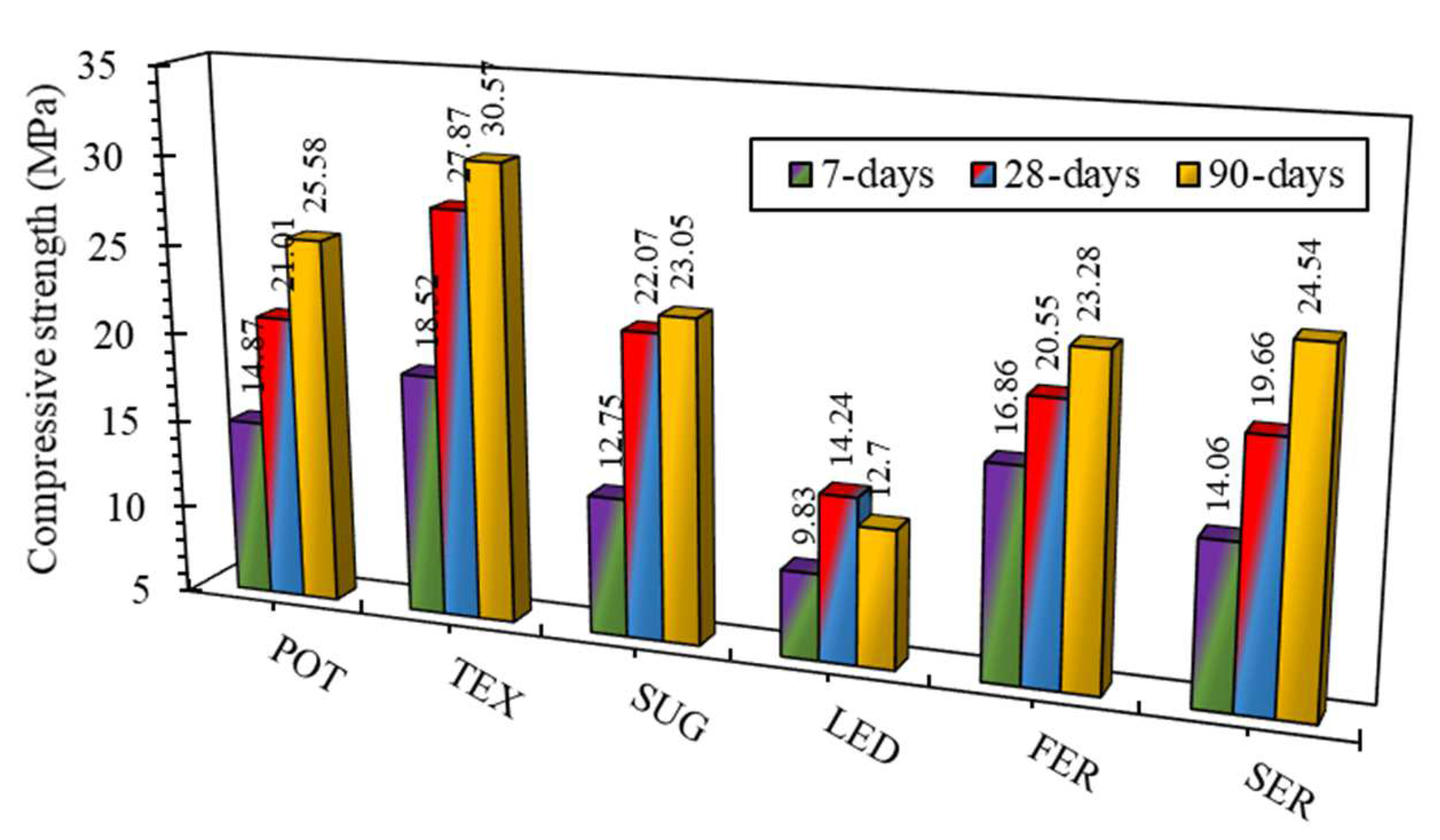

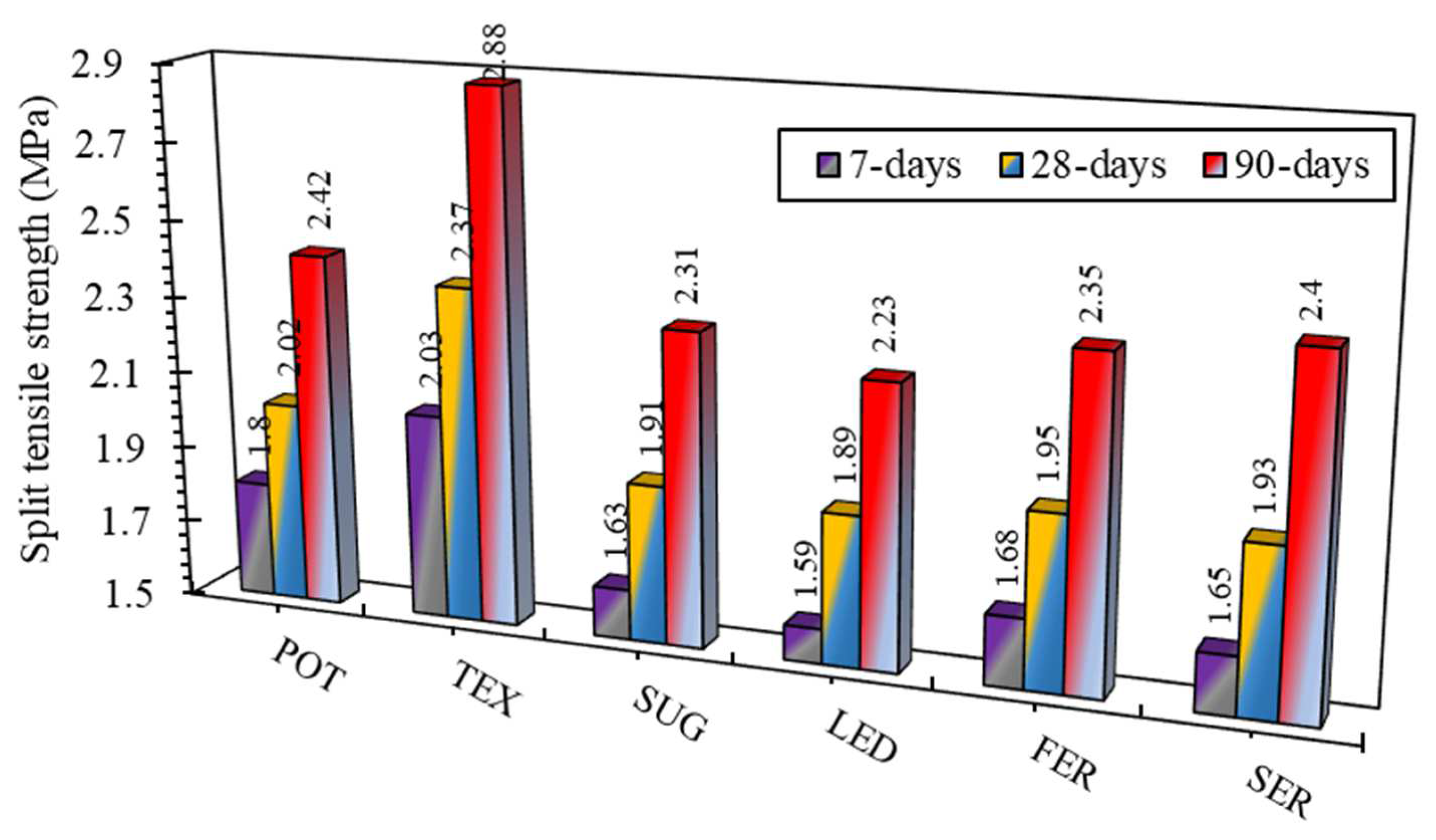

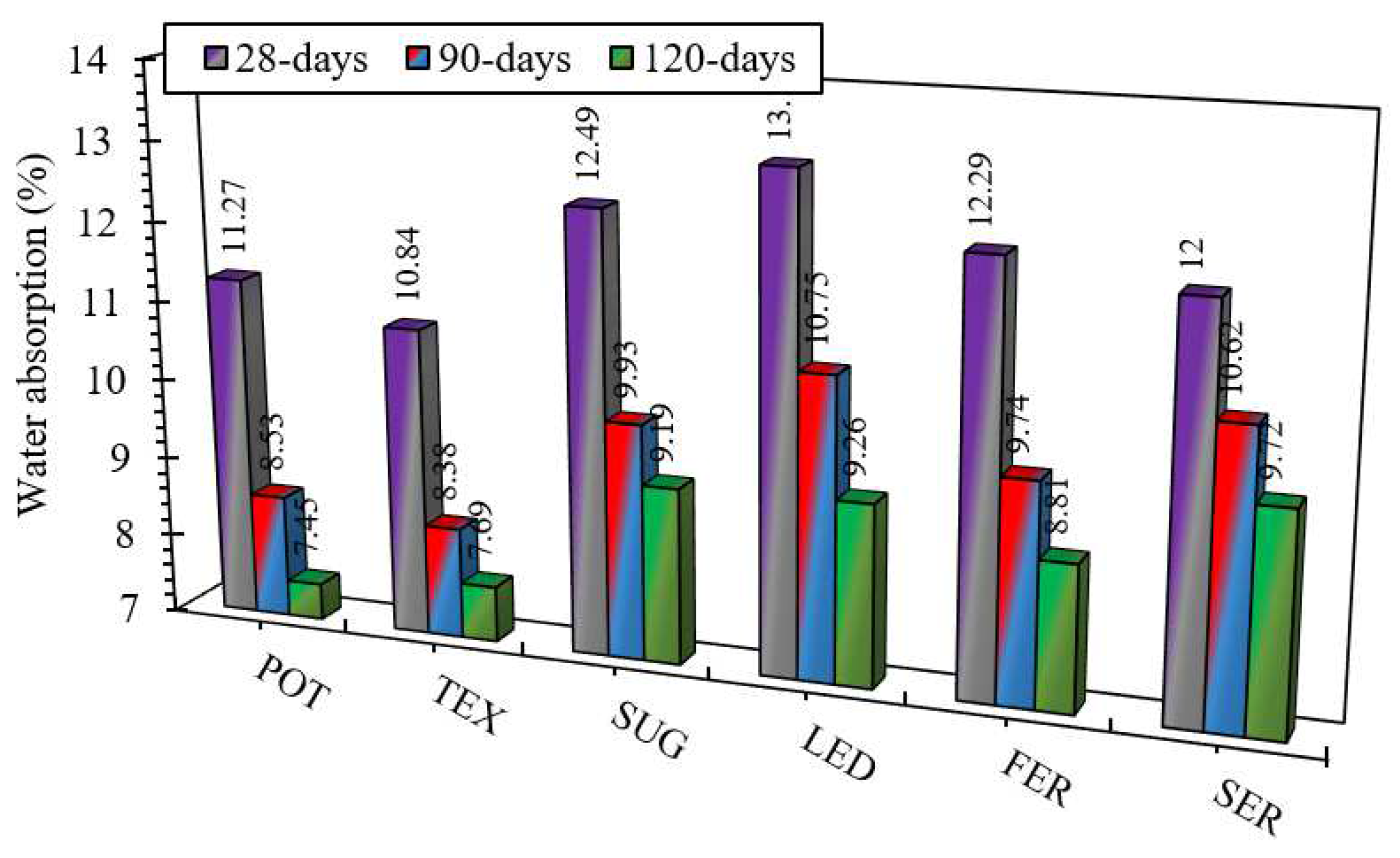
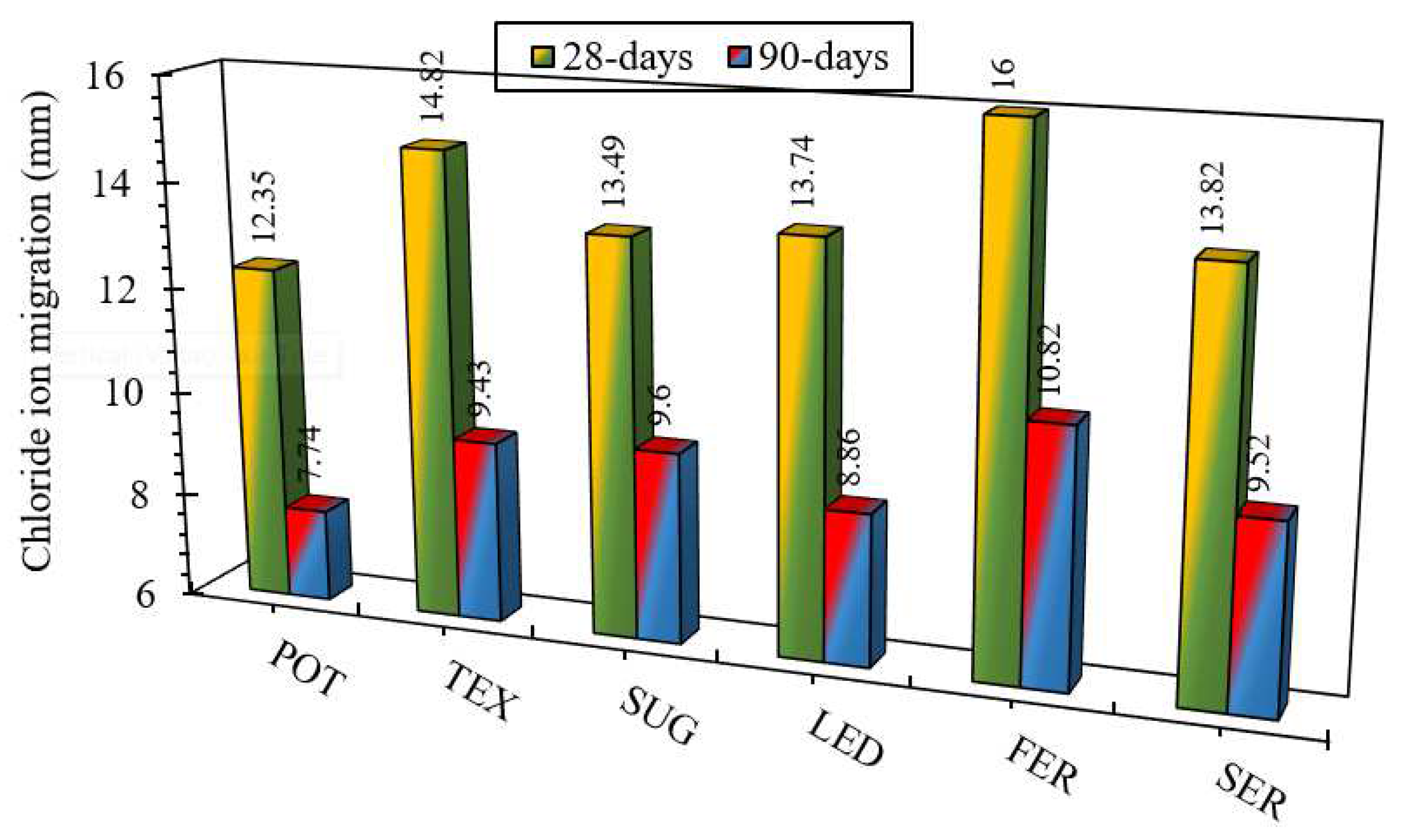
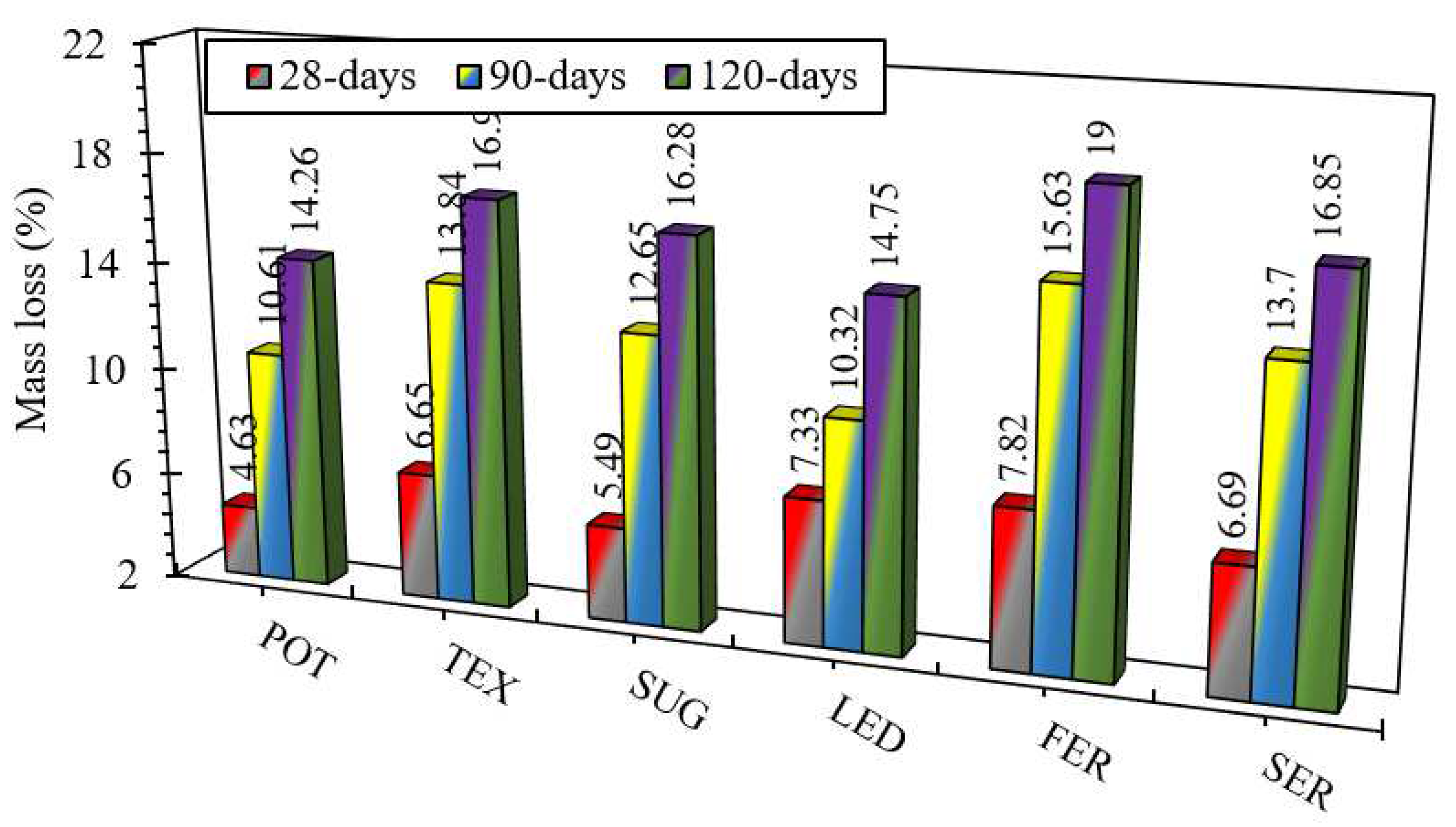
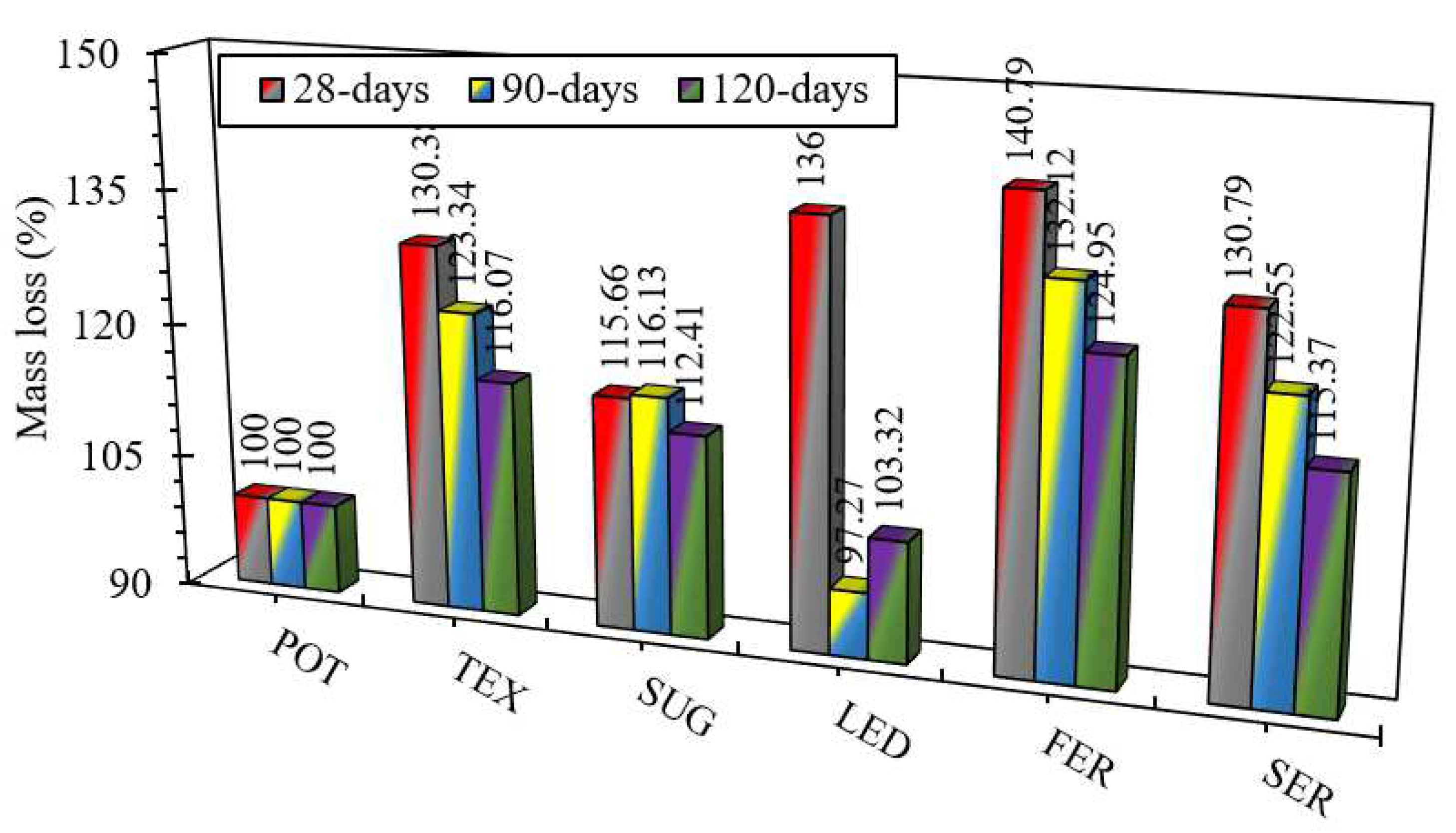
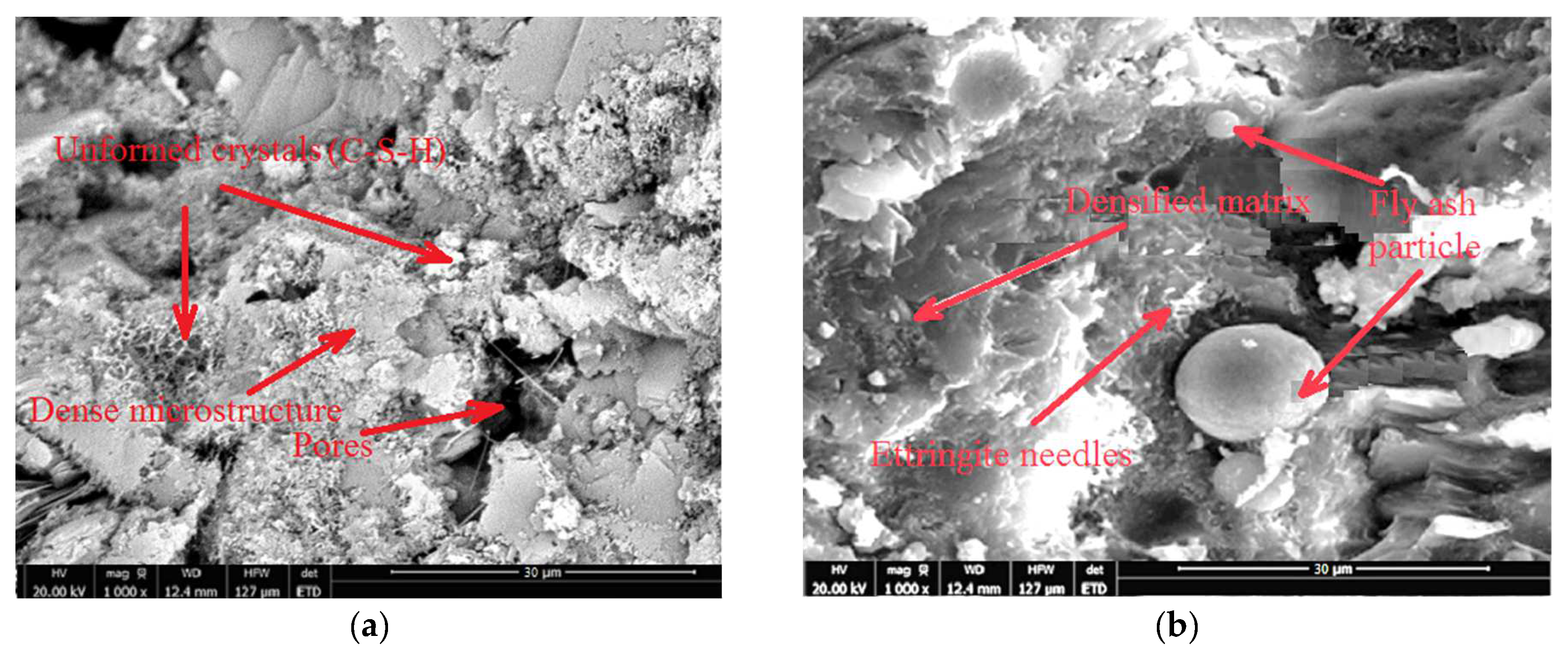
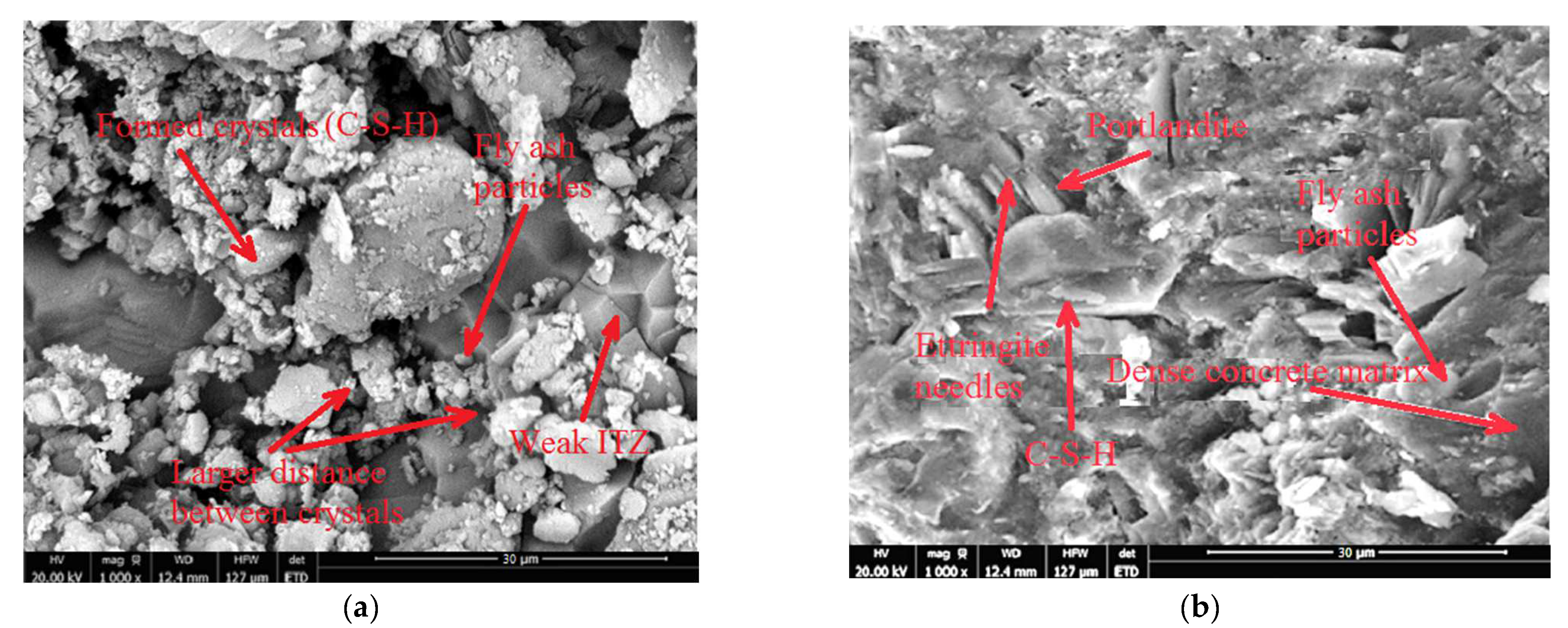

| Physical Properties | Chemical Properties | ||
|---|---|---|---|
| Parameter | Value | Compound | Percentage |
| Consistency [52] | 28.90% | SiO2 | 19.2% |
| Fineness (Blaine Test) | 2765 (cm2/g) | CaO | 58.1% |
| Specific surface area [53] | 325 m2/kg | Fe2O3 | 6.0% |
| Soundness [54] | No expansion | Na2O | 0.4% |
| Specific gravity [55] | 3.0 | Al2O3 | 5.7% |
| Initial setting time [56] | 110 min | SO3 | 2.2% |
| Final setting time [56] | 225 min | MgO | 5.3% |
| Strength at 3 days [57] | 38.2 MPa | Loss of ignition | 2.9% |
| Strength at twenty-eight days [57] | 42.5 MPa | K2O | 0.8% |
| Property | Sand | RCA |
|---|---|---|
| Water absorption after 24 h (%) | 2.33 | 7.30 |
| Dry density (kg/m3) | 1630 | 1295 |
| Specific gravity | 2.62 | 2.23 |
| Fineness modulus | 2.43 | - |
| Maximum size (mm) | 4.75 | 12.0 |
| Minimum size (mm) | - | 4.75 |
| Chemical Properties | Physical Properties | ||
|---|---|---|---|
| Compound | Percentage | Parameter | Value |
| SiO2 | 57.9% | Consistency [52] | 25.98% |
| CaO | 3.21% | Specific surface area [53] | 389 m2/kg |
| Fe2O3 | 2.3% | Fineness (Blaine Test) | 2950 (cm2/g) |
| Na2O | 1.02% | Soundness [54] | No expansion |
| Al2O3 | 31.32% | - | - |
| SO3 | 1.01% | - | - |
| MgO | 0.7% | - | - |
| Parameter (Unit) | POT | LED | FER | TEX | SUG | SER |
|---|---|---|---|---|---|---|
| pH value | 7.00 | 7.30 | 2.50 | 7.10 | 7.20 | 6.00 |
| Hardness (mg/L) | 357.7 | 706.58 | 2508.8 | 335.16 | 2077.6 | 362.6 |
| Alkalinity (mg/L) | 80.36 | 95.06 | 0.50 | 47.04 | 120.54 | 84.28 |
| Bicarbonates (mg/L) | 33.56 | 37.88 | 0.40 | 296 | 135 | 43 |
| DO (mg/L) | 6.17 | 2.74 | 2.35 | 5.19 | 2.94 | 2.54 |
| COD (mg/L) | 18.22 | 412.58 | 1024.1 | 117.6 | 931 | 191.6 |
| BOD (mg/L) | 14.70 | 304.78 | 597.8 | 68.6 | 705.6 | 127.6 |
| TSS (mg/L) | 33.32 | 491.96 | 64.68 | 25.48 | 71.54 | 66.64 |
| TDS (mg/L) | 880.04 | 1074.08 | 5117.56 | 380.24 | 4018.98 | 480.2 |
| Turbidity (NTU) | 1.07 | 245 | 3.18 | 1.20 | 24.5 | 36.26 |
| Conductivity (m-s/cm) | 1.37 | 1.82 | 8.33 | 0.98 | 6.46 | 0.86 |
| Fluoride (mg/L) | 0.39 | 1.12 | 0.09 | 1.69 | 0.42 | 0.11 |
| Chloride (mg/L) | 14.7 | 333.2 | 858.48 | 62.13 | 844.76 | 245 |
| Sulphate (mg/L) | 8.82 | 739.9 | 927.08 | 102.9 | 205.8 | 113.68 |
| Iron (mg/L) | 0.76 | 0.85 | 3.52 | 0.94 | 1.45 | 1.20 |
| Zinc (mg/L) | - | 1.32 | - | - | 0.18 | - |
| Nitrate (mg/L) | 1.86 | 137.2 | 70.56 | 2.54 | 37.24 | 11.76 |
| Cement | RCA | Fine Aggregates | Water Content | Coal Ash | w/c Ratio |
|---|---|---|---|---|---|
| 331 | 1155 | 625 | 166 | 83 | 0.5 |
| Groups | Count | Sum | Average | Variance | ||
|---|---|---|---|---|---|---|
| POT | 3 | 63.02774 | 21.00924667 | 2.219700211 | ||
| LED | 3 | 42.714375 | 14.238125 | 7.903666312 | ||
| FER | 3 | 58.973625 | 19.657875 | 4.303503563 | ||
| TEX | 3 | 83.619 | 27.873 | 4.684854938 | ||
| SUG | 3 | 61.652625 | 20.550875 | 3.827338922 | ||
| SER | 3 | 66.21975 | 22.07325 | 4.772577937 | ||
| ANOVA | ||||||
| Source of variation | Sum of squares | Degrees of freedom | Mean squares | p-value | ||
| Between groups | 288.1695593 | 5 | 57.63391185 | 8.47863525 | 0.000206664 | 3.105875239 |
| Within groups | 55.42328377 | 12 | 4.61860698 | |||
| Total | 343.592843 | 17 | ||||
| Groups | Count | Sum | Average | Variance | ||
|---|---|---|---|---|---|---|
| POT | 3 | 6.05625 | 2.01875 | 0.001032234 | ||
| LED | 3 | 5.6715 | 1.8905 | 0.050376422 | ||
| FER | 3 | 5.778375 | 1.926125 | 0.006819516 | ||
| TEX | 3 | 7.103625 | 2.367875 | 0.176529 | ||
| SUG | 3 | 5.835375 | 1.945125 | 0.052237828 | ||
| SER | 3 | 5.735625 | 1.911875 | 0.118097766 | ||
| ANOVA | ||||||
| Source of variation | Sum of squares | Degrees of freedom | Mean squares | p-value | ||
| Between groups | 0.489910844 | 5 | 0.097982169 | 1.451255274 | 0.275778446 | 3.105875239 |
| Within groups | 0.810185531 | 12 | 0.067515461 | |||
| Total | 1.300096375 | 17 | ||||
| Groups | Count | Sum | Average | Variance | ||
|---|---|---|---|---|---|---|
| POT | 3 | 23.231985 | 7.743995 | 1.132812315 | ||
| LED | 3 | 24.46437 | 8.15479 | 0.754597331 | ||
| FER | 3 | 28.568925 | 9.522975 | 4.678102345 | ||
| TEX | 3 | 28.283745 | 9.427915 | 4.715792447 | ||
| SUG | 3 | 32.44941 | 10.81647 | 0.808297081 | ||
| SER | 3 | 28.813365 | 9.604455 | 0.60030996 | ||
| ANOVA | ||||||
| Source of variation | Sum of squares | Degrees of freedom | Mean squares | p-value | ||
| Between groups | 18.43320295 | 5 | 3.68664059 | 1.743104637 | 0.199393883 | 3.105875239 |
| Within groups | 25.37982296 | 12 | 2.114985246 | |||
| Total | 43.81302591 | 17 | ||||
| Groups | Count | Sum | Average | Variance | ||
|---|---|---|---|---|---|---|
| POT | 3 | 31.8402252 | 10.6134084 | 0.604905146 | ||
| LED | 3 | 30.9456084 | 10.3152028 | 2.151876247 | ||
| FER | 3 | 41.1015423 | 13.7005141 | 1.005832652 | ||
| TEX | 3 | 41.5183524 | 13.8394508 | 1.037664326 | ||
| SUG | 3 | 46.8962193 | 15.6320731 | 1.098640583 | ||
| SER | 3 | 37.9500513 | 12.6500171 | 0.888944267 | ||
| ANOVA | ||||||
| Source of variation | Sum of squares | Degrees of freedom | Mean squares | p-value | ||
| Between groups | 62.66853252 | 5 | 12.5337065 | 7.07892669 | 0.000364576 | 3.105875239 |
| Within groups | 13.57572644 | 12 | 1.131310537 | |||
| Total | 76.24425896 | 17 | ||||
Publisher’s Note: MDPI stays neutral with regard to jurisdictional claims in published maps and institutional affiliations. |
© 2022 by the authors. Licensee MDPI, Basel, Switzerland. This article is an open access article distributed under the terms and conditions of the Creative Commons Attribution (CC BY) license (https://creativecommons.org/licenses/by/4.0/).
Share and Cite
Raza, A.; Saad, N.; Elhadi, K.M.; Azab, M.; Deifalla, A.F.; Elhag, A.B.; Ali, K. RETRACTED: Mechanical, Durability, and Microstructural Evaluation of Coal Ash Incorporated Recycled Aggregate Concrete: An Application of Waste Effluents for Sustainable Construction. Buildings 2022, 12, 1715. https://doi.org/10.3390/buildings12101715
Raza A, Saad N, Elhadi KM, Azab M, Deifalla AF, Elhag AB, Ali K. RETRACTED: Mechanical, Durability, and Microstructural Evaluation of Coal Ash Incorporated Recycled Aggregate Concrete: An Application of Waste Effluents for Sustainable Construction. Buildings. 2022; 12(10):1715. https://doi.org/10.3390/buildings12101715
Chicago/Turabian StyleRaza, Ali, Noha Saad, Khaled Mohamed Elhadi, Marc Azab, Ahmed Farouk Deifalla, Ahmed Babeker Elhag, and Khawar Ali. 2022. "RETRACTED: Mechanical, Durability, and Microstructural Evaluation of Coal Ash Incorporated Recycled Aggregate Concrete: An Application of Waste Effluents for Sustainable Construction" Buildings 12, no. 10: 1715. https://doi.org/10.3390/buildings12101715
APA StyleRaza, A., Saad, N., Elhadi, K. M., Azab, M., Deifalla, A. F., Elhag, A. B., & Ali, K. (2022). RETRACTED: Mechanical, Durability, and Microstructural Evaluation of Coal Ash Incorporated Recycled Aggregate Concrete: An Application of Waste Effluents for Sustainable Construction. Buildings, 12(10), 1715. https://doi.org/10.3390/buildings12101715










